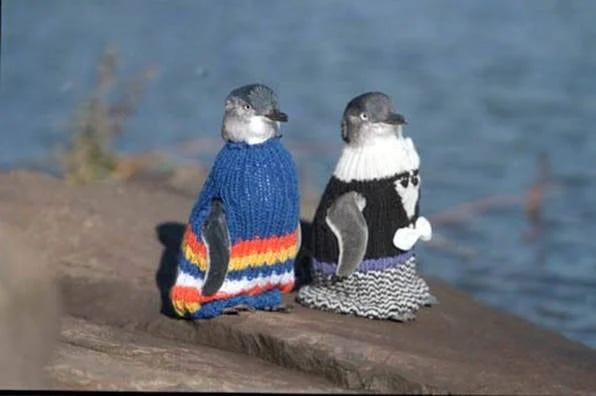Some conversations about disasters recently sent me back down a rabbit hole of my own disaster experience, back to the Rena Oil Spill.
My own experience with this disaster isn’t all interesting. I was only there over the holiday season, after the worst was over.
So, rather than do things that have been done better elsewhere, here I want to explore the art of the Rena disaster.
Tens of thousands of people were affected by this disaster. The spill hit a major population center, a location that might be considered New Zealand’s answer to Florida (in that sense of vacations, retirement villages, and seaside mansions). As far as I can tell, almost anyone with any connection to this place with almost any level of artistic talent had some kind of artistic response to the Rena Disaster.
In a world increasingly rocked by environmental catastrophes, it’s an interesting question:
How does a community respond artistically to the environmental destruction of their home?
That’s a question I wish I didn’t have firsthand experience with, but unfortunately I do.
So let’s take a look at that.
(Some Limitations: This is going to be fairly quick and rough. I’ve not been back there in years. To my knowledge no one has ever tried to collate the artistic output of this disaster, and doing so would be a monumental task. I’m limited to what I can find online, and many artistic works are ephemeral or in private collections, and I can’t reproduce everything here. That said, we can find a few things and some major themes.)
The Disaster
This event was New Zealand’s worst maritime environmental disaster, the second most expensive salvage operation in history (second only to the Costa Concordia), and I’ve seen it described as the most complex shipwreck in history.
To call this an oil spill feels like a misnomer. This was an everything spill. A nightmare of consumer goods, industrial chemicals, thousands of tonnes of milk powder, everything and anything, and yes, also some oil.
The legacy continues on even now. Years later children could go swimming, and come out covered in little black spots. Trash still washes up after storms, with the question: was it the Rena, or are the oceans all just trash now? The wreck of the Rena is still out there at the bottom of the sea, much to the displeasure of local Maori longing to see the mauri (life force) of their fishing grounds, their home, restored.
We all have landscapes that play a formative influence on our lives. For me the beaches of the Bay of Plenty are one of those places. That’s true for a lot of people. It’s a landscape of beauty and abundance, rich in the meanings of myth and history.
And it got trashed.
A documentary appears to be in the works, and might be coming out in the near future. They have some teasers which give a good overview of events.
The wreck:
The government:
The community:
The wildlife:
Maori:
However, if you prefer your history in folk song you can just listen to this (I am now a true believer that all events should have a official folk song!):
Okay, so that’s what happened. Now let’s get into the art.
The Overwhelm of Images
By far the largest artistic output of the disaster has to be photographs and film. Even amateur photos can take on artistic value, and plenty of professionals were out there too.
Maritime NZ hired official photographer’s to document the event. The ten year anniversary of the disaster included a public display of their photos.
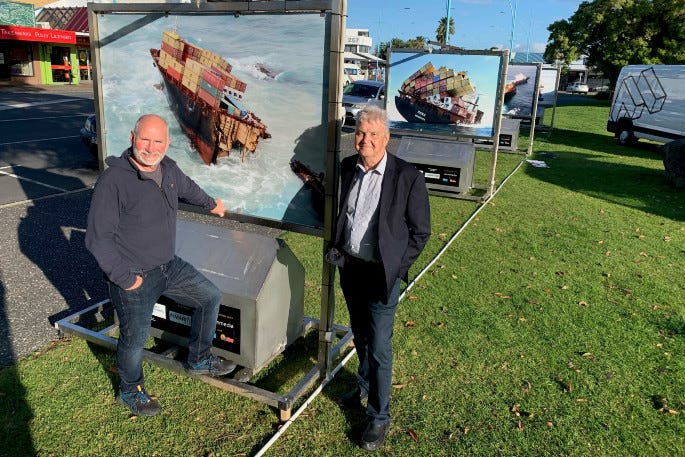
Photos like these are raw, unprocessed, and often deeply distressing. Of all the art forms, raw footage and photography has undergone the least internal meaning making. It’s pure events, in all their chaos.
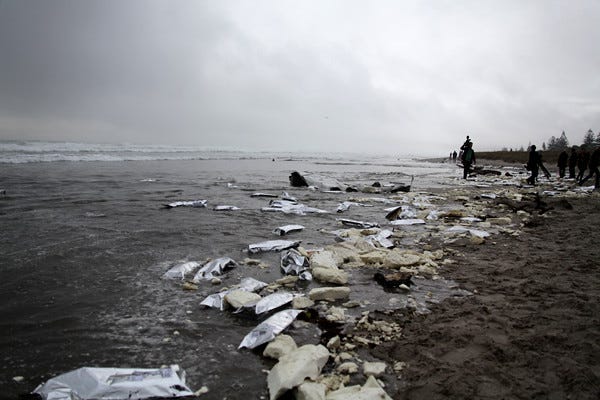
Any mention of the disaster tends to be joined by a flood of this raw imagery.
The Anger
When I was first asked about how I felt about the disaster that was then unfolding, I answered one word: “Angry.”
Unlike a earthquake someone was to blame.
I’ve heard this described as “recreancy”: the experience of institutional failure, where something that was assumed to be safe and managed turns out not to be. For the Rena this failure occurred both in the accident itself (why are unsafe vessels registered in a failed state allowed to operate here?), and in the governmental response (why are we so unprepared for this?).
This anger shows up in the arts.
An superb example of this energy is some slam poetry by Te Kahu Rolleston.
Questions of money, power, and blame are all in direct focus.
We also got anger in mural form:
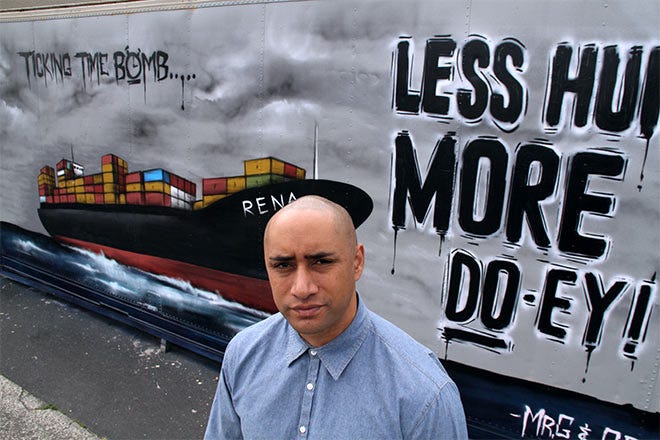
Politics
The disaster took on national, even international proportions. The blog of politics lecturer Bryce Edwards has a good collection of the flood of Rena satire and political cartoons.
The disaster took place during an election year, and got caught up in the debate over the then National Government’s (centre-right party) plans for deep sea oil drilling.
Greenpeace made artistic use of the disaster in their campaigning with their morbid “Oil on Canvas” exhibition, made from an actual oil soaked dead penguin pressed onto canvas.

The people making these political statements are not necessarily locals. Events have been caught up into the wider world, and the arts play their role.
Yes, We Discovered We Had Penguins
Little Blue Penguins have become the poster child for the Rena disaster. If an artwork is produced about the Rena disaster, there’s a decent chance it will include a penguin.
Which is odd.
Certain places in New Zealand are famous for penguins. Tauranga is not one of them. I only ever saw a Little Blue Penguin there once. Only after penguins washed up dead did we come to a collective realization that they had in fact existed in the first place.
We didn’t truly know what we had.
Penguins really are everywhere in Rena art.
The memorial sculpture to the disaster features penguins. The monument is done in a style reminiscent of a war memorial, except the soldiers are penguins. The title “The Sea’s That Way” was inspired by a child who called out directions to the penguins as they were released.
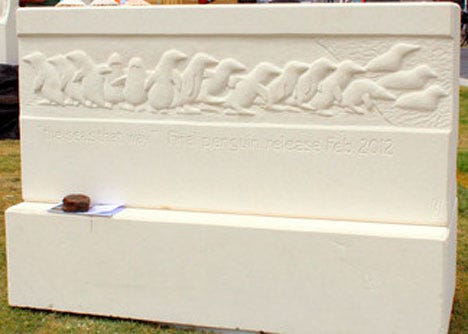
At least two children’s books about penguins have been written. Mōtītī Blue and the Oil Spill tells the story of the disaster from the point of view of a penguin. As far as I can tell, penguin related children’s books are the only literary output of the Rena disaster so far (at least as far as can easily be found online).
Perhaps the weirdest outpouring of penguin related artistic effort was the case of the Viral Internet Penguin Sweater Knitting Campaign.
This was kicked off by a wool company, and true to the nature of viral internet phenomena might’ve been a bit misguided. Either way, it does say something about the human race that one of our major artistic responses to a disaster was to make stylish woollen tuxedos for animals.
This craze also gave us our second penguin-centric children’s book in Granny McFlitter the Champion Knitter, about a knitting crazed old lady.
So, why did penguins become the symbols of the disaster?
Penguins are very cute, and I suspect we are reaching for some kind of comfort. They provide an almost humanoid personification to nature. There is also something soothing in their narrative arc (disaster-rescue-healing-release) that stands symbolic for larger story.
The penguins have been returned to the sea.
Everything’s okay now.
Even if we didn’t realize they lived here before, we do know now.
The Art World
One of the stranger artistic moments I’ve come across is from Tongan performance artist Kalisolaite ‘Uhila. His previous performances have included living with a pig and being homeless.
He’s not a local. But he did pay a visit. I’m not entirely sure what he actually did.
“[The performance] will enforce the idea that the tragedies occurring in our country extend beyond media and, like the remains of my work, will be left on our streets and doorsteps forcing us to acknowledge its presence. The remnants of my performance will act as an installation piece that serves as a reminder of the recent tragedy.” (source)
The local art gallery held an exhibition on the tenth anniversary. Again, having not been there I can’t say much. However, judging by the giant Ka Mate (Maori for death & dying), even ten years later the feeling is raw and unprocessed. The initial shock of destruction lingers.

The average local is probably more like to read a kids book about penguins than engage with a avant garde performance piece that dumps garbage in their doorway, but it’s all part of the mix.
Conclusion
Much more is out there than what I’ve covered, but I think this gets much of the core. The overwhelming shock, the anger, the way events get caught up into larger struggles, the way it never really goes away, and the grasping for sense – even if the best we can do is children’s books about penguins.
The emotional processing of an event of this magnitude takes time, indeed perhaps never truly ends. The moment of anger and politics has largely passed. Now a decade later we might be entering into a more reflective phase. We will perhaps be left with documentaries about what happened back then, plus statues and books that give us a soothing story about how we rescued the penguins, and how even far away and feeling powerless would could still knit the penguins sweaters.
And yet, oil doesn’t just go away.
The forces that lead to the disaster haven’t much changed. In that world, its hard to make meaning out of the chaos of death.





